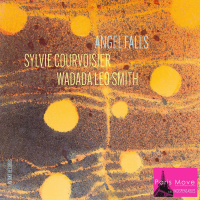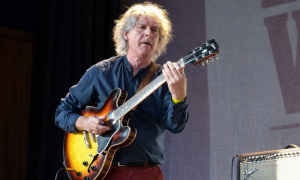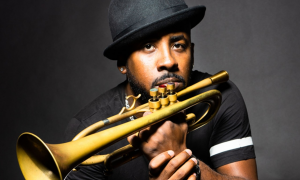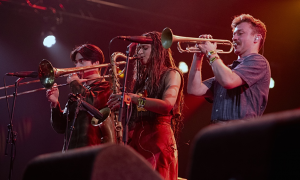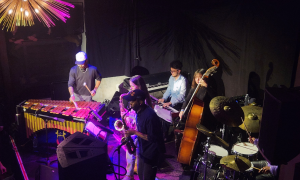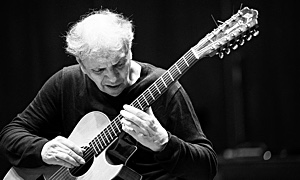Home » Jazz Articles » Live Review » Molde Jazz: Day 6, July 18, 2009
Molde Jazz: Day 6, July 18, 2009
Break of Day in Molde / Crimetime Orchestra / Jaga Jazzist / Arve Henriksen Closing Concert
Molde Jazz
Molde, Norway
July 18, 2009
It's almost impossible to believe, that after the late nights of Molde Jazz, hundreds of people would make the trek halfway up the hill towards where singer/songwriter Leonard Cohen performed the previous evening, to an outdoor amphitheater on the last day of the festival, for an early morning performance by trumpeter and artist in residence Arve Henriksen, keyboardist and Norwegian icon Jon Balke, percussionist Terje Isungset, cellist Svante Henryson and dancer Therese Skauge. But by the time the "Break of Day in Molde" concert began at 7:00 AM—long after the sun had begun to rise in the sky hours earlier after a true night of only a couple hours—the stands were full, with a waking audience provided with free coffee and juices, courtesy of Molde Jazz.

Only in Norway would an idea such as this even be considered, let alone be this well attended. Maybe it's the long days—even at night it's never quite as dark as it is at other times of the year—that discourage sleep. Or perhaps it's a certain intrepid personality that places culture, for a brief time at least, over such basic necessities as sleep. But either way, there were nearly a thousand people waiting for Henriksen to appear with this one time-only group.
- Break of Day in Molde: Arve Henriksen
- Crimetime Orchestra
- Jaga Jazzist
- Arve Henriksen Closing Concert
- Festival Wrap-Up
Break of Day in Molde: Arve Henriksen
Henriksen's week at Molde Jazz as artist in residence has been a remarkable consolidation of past works and a view into the future of an artist who never seems to stand still. With boundless energy, he's involved in seemingly countless projects, but for this performance he appeared to turn the musical direction over to Balke, with an hour-long set of music that sounded like a miniature version of Balke's longstanding Magnetic North Orchestra, responsible for a series of albums including Diverted Travels (ECM, 2004). Without knowing who wrote the music, Balke's presence—as an influential musician whose reach extends beyond his own music, and whose Siwan (2009) is an ECM masterpiece as important, if not more so, as Jan Garbarek's 1994 collaboration with The Hilliard Ensemble, Officium—was felt in the music; his curious and distinctive harmonic and rhythmic approach a definer for the entire performance.
 Beginning with music that was as gentle as the warmth of the sun as it continued to rise, Henriksen's liquid tone was beyond lyrical, creating music that couldn't have been more appropriate to the outdoor context where it was being made. There were no sharp surfaces, only a kind of impressionism that created a soft cushion for Skauge to dance to. Skauge's movements were elegantly interpretive, but things went both ways; as much as she responded to the music around her, the musicians took cues from her movements as well.
Beginning with music that was as gentle as the warmth of the sun as it continued to rise, Henriksen's liquid tone was beyond lyrical, creating music that couldn't have been more appropriate to the outdoor context where it was being made. There were no sharp surfaces, only a kind of impressionism that created a soft cushion for Skauge to dance to. Skauge's movements were elegantly interpretive, but things went both ways; as much as she responded to the music around her, the musicians took cues from her movements as well.
It was a terrific opportunity to hear the remarkable Henryson in a more open environment. His work with singer Kristin Asbjørnsen was perfectly fitting, but he had to function within the songwriter's more structured context. Here, despite no shortage of form, freedom was also a part of the picture, allowing the cellist to be more intimately interactive with the rest of his band mates. His rapport with Henriksen was especially noticeable, as the two worked off each other, most often in the subtlest of ways.
Isungset has been on the Norwegian scene for a number of years, working largely in improvised contexts but is, perhaps, best known for his ice concerts and CDs, where the percussionist literally builds instruments out of ice and collaborates with artists including Henriksen, singer Sidsel Endresen, harpist Iro Haarla and trumpeter Per Jørgensen, to create music that sounds not quite of this world. Here, however, he used more conventional percussion, though his approach was anything but. Using rocks—large, rounded ones and flate, slate-like slabs—he demonstrated that music truly can be found anywhere, as his stone-on-stone often created notes that were in perfect harmony with the music around him.
Playing keyboards, but also utilizing, in addition to Henriksen, some of the gongs strung along the back of the stage—especially a particularly large one that he struck with the palm of his hand to create a deep bass sound that was absolutely huge—Balke created layers of soft electric piano washes and added some sound samples to the mix. The music may have seemed amorphous at times, but equally it found its way to groove too, especially towards the end of the show, when Henryson began working with Isungset to create a potent rhythm, over which Henriksen first sang, then turned comic in a poke at early morning shows that encourage their audience to get up, stretch and do other physical activities—and he managed to get the hundreds of people at the Reknesparken amphitheater to do just that, amidst plenty of laughter.
 l:r: Jon Balke, Therese Skauge, Svante Henryson, Arve Henriksen, Terje Isungset
l:r: Jon Balke, Therese Skauge, Svante Henryson, Arve Henriksen, Terje Isungset
The music gradually became more energetic to coincide with the emergence of the day and the waking audience; but it was most remarkable for its putting to music an occurrence in nature that most take for granted. A short encore was an appropriate end to the performance, a singable melody over a gentle foundation that left the audience feeling joyous and optimistic about the day ahead. If only they could bottle that and use it instead of alarm clocks to wake people up.
The final day of Molde Jazz 2009 wrapped up with three eagerly anticipated concerts, including a rare encounter, a triumphant return and a shifting, rarely heard collective that put on one of the most relentless performances of the festival, one that combined cued form with unfettered free play. Crimetime Orchestra began in 2002 as a free jazz big band informed by the music of Sun Ra, Ornette Coleman (the group's use of two drummers and two bassists harkening back to the 79 year-old innovator, heard recently in performance at the 2009 Festival International de Jazz de Montreal), Bitches Brew-era Miles Davis and classical composers including Karlheinz Stockhausen.
 Front l:r: Ingebrigt Håker Flaten, Per Oddvar Johansen, Paal Nilssen-Love, Mats Eilertsen
Front l:r: Ingebrigt Håker Flaten, Per Oddvar Johansen, Paal Nilssen-Love, Mats Eilertsen
Of course, with some of the leading lights on Norway's free jazz scene and many others—including bassists Ingebrigt Håker Flaten and Mats Eilertsen, drummers Per Oddvar Johansen and Paal Nilssen-Love (also a participating member of the Chicago scene via reeds player Ken Vandermark), trombonist Øyvind Brække (also of the smaller collective The Source, with Trygve Seim, Eilertsen and Johansen), keyboardist Christian Wallumrød, saxophonists Jon Klette, Vidar Johansen, Gisle Johnsen and Kjetil Moster, hornist Sofie Tafjord, trumpeter Sjur Miljeteig and guitarist Stian Westerhus—who has recently returned from years spent in England and has leapt onto the scene with a number of groups—there's more than enough playing power to create some seriously joyous noise. And so it was, when the group took to the Kulturhuset stage, that it took very little time hitting its stride with a kind of collective controlled chaos that may have appeared unstructured when the group was firing on all cylinders—as it did much of the time—but remained driven by certain roadmaps that created rallying points for the group throughout its 80-minute set.
Individual solos abounded within the group's fuller context, as did breaking the 13-piece ensemble into a variety of subsets to provide respite from the wall of sound that came off the stage when everyone was in the pool and was, despite Wallumrød's keyboard, Tafjord's processing and Westerhus' array of foot pedals, a largely acoustic performance. At least, even though Ingebrigt Håker Flaten and Mats Eilertsen were playing electric instruments, it sure felt that way, with the two drummers and horn section creating such a massive sound that everything else only added to a core density. Wallumrød—who went from the somewhat austere but darkly beautiful performance with his own ensemble on Wednesday to the ordered cacophony—was wearing earplugs, a wise idea given just how much sound was coming off the stage, even before the PA system was taken into consideration.
Eilertsen could be seen experimenting with effects and some unorthodox approaches to his bass, including using a glass slide not to create sliding notes, but to create a persistent wash of sound, and combining electronics with bending his strings to, at one point, sound like a foghorn. Håker Flaten was more about high octane playing, creating a wall of low-register sound that rarely turned to anchoring the group, but when he did in one section of its two lengthy and continuous pieces, working in concert with Johanssen and Nilssen-Love, it was all the more dramatic. And while the jagged power of Crimetime Orchestra was a defining feature, there were moments of respite, although they remained extreme and filled with surprise.
 With the powerhouse playing of Johanssen and Nilssen-Love a particular high point for the group, it was Westerhus—who played with reckless abandon throughout the set, but took a lengthy solo near the end of the second piece—that was the surprise star of the show. Possessing a wealth of sonic invention, raw and angular ideas and a magnetic stage presence made all the more noticeable by his physical separation from the rest of the group on stage right—largely, no doubt, because of the footprint of his rig and the sheer volume coming for his VOX AC-30 (the longtime favorite of many of Norway's most famous guitarists, including Eivind Aarset and Terje Rypdal)—Westerhus, who has released the first album on Rune Grammofon's new, all-vinyl label The Last Record Company, Galore (2009), is on the ascendant. A member of the reformed Jaga Jazzist and recently replacing Aarset in trumpeter Nils Petter Molvaer's group, his wildly creative approach to turning the guitar into something much bigger texturally remains a more direct contrast to Aarset's less guitaristic palette.
With the powerhouse playing of Johanssen and Nilssen-Love a particular high point for the group, it was Westerhus—who played with reckless abandon throughout the set, but took a lengthy solo near the end of the second piece—that was the surprise star of the show. Possessing a wealth of sonic invention, raw and angular ideas and a magnetic stage presence made all the more noticeable by his physical separation from the rest of the group on stage right—largely, no doubt, because of the footprint of his rig and the sheer volume coming for his VOX AC-30 (the longtime favorite of many of Norway's most famous guitarists, including Eivind Aarset and Terje Rypdal)—Westerhus, who has released the first album on Rune Grammofon's new, all-vinyl label The Last Record Company, Galore (2009), is on the ascendant. A member of the reformed Jaga Jazzist and recently replacing Aarset in trumpeter Nils Petter Molvaer's group, his wildly creative approach to turning the guitar into something much bigger texturally remains a more direct contrast to Aarset's less guitaristic palette.
There were other high points, including the empathic interaction between Johanssen and Nilssen-Love, Tafjord and Wallumrød's out-of-this world electronics, a fiery baritone saxophone/drums duet with Nilssen-Love and brief encounter between Håker Flaten and Johansen. But the group's greatest benchmark was when it was playing as a 13-piece ensemble, creating an almost impenetrable sonic assault of power that was only hinted at on its one release, Life is a Beautiful Monster (Jazzaway, 2005).
Jaga Jazzist, returning after a four-year hiatus (with the exception of one 2007 date in Singapore), was one of the festival's most eagerly anticipated shows. Massively popular in Norway and with no small following abroad, the group's music revolves largely—but not exclusively—around the writing of Lars Horntveth. The multi-instrumentalist—whose Kaleidoscopic (Smalltown Supersound, 2009) is one of the year's most ambitious, largely solo efforts—manages to combine everything from Steve Reichian-minimalism to Frank Zappa-informed structural complexity, all with a strong rock energy, serpentine but singable melodies and a rock and roll stage presentation that made it one of the Molde Jazz's most impressive shows.
 l:r: Erik Johannessen, Line Horntveth, Lars Horntveth, Øysten Moen
l:r: Erik Johannessen, Line Horntveth, Lars Horntveth, Øysten Moen
In order to execute the group's highly arranged charts, Jaga Jazzist needed—and continues to have—a group of nine musicians who all at least double, if not triple, quadruple or more, on a variety of instruments ranging from tuba, flute and to bass clarinet to vibraphone, double-bass, electric guitars, keyboards and more. Lars Hortveth—one of three siblings in a group that also includes sister Line on tuba, flute, percussion, melodica and vocals, and brother Martin who, in addition to being the group's onstage spokesperson, plays drums, percussion and vocals—plays guitar, lap steel guitar, clarinet, bass clarinet, keyboards, and tenor and soprano saxophones, switching between them so quickly that it seems like sleight of hand.
If Jaga Jazzist fits within the jazz purview—and it most certainly does, albeit in the broadest possible definition—it's more aligned with detailed construction than it is heavy improvisation. That said, there are opportunities for soloing, with trumpeter Mathias Eick—who also plays double-bass, vibraphone and keyboards, and whose ECM debut, The Door (2008), was one of last year's picks in the New Discoveries category—delivering one of the performance's first great solos, and guitarist Stian Westerhus essentially continuing the same sonic assault as he provided with Crimetime Orchestra earlier in the day. A little less in the spotlight than with Crimetime—crammed, as he was, with so many others on a stage barely large enough to contain what looked like a music store shop front—it's clear that Westerhus, who also plays in the improvising duo Puma, has a singular vision and approach to the guitar, but one that can be transported into many different contexts.
 l:r: Martin Horntveth, Even Ormestad, Stian Westerhus, Andreas Mjøs
l:r: Martin Horntveth, Even Ormestad, Stian Westerhus, Andreas Mjøs
Blending unique and ever-shifting combinations of instruments with hints of electronica—though Martin Horntveth's powerful but elastic drumming was a more vivid driver than any programmed beats could be—the set was largely culled from a yet-to-be-released new album that should see the light of day in early 2010. Music from the group's last release, What We Must (Smalltown Supersound, 2005), as well as a smattering of older material, was also included in a lengthier than normal festival performance to a packed house at Bjørnsonhuset, where the seats had been removed for a standing room-only crowd that was clearly as excited to be seeing Jaga Jazzist as the group was to be back in action. If the new music was any indicator, the forthcoming album will fit within the group's overall body of work while moving it forward at the same time. An influential group that has reached even Canadian shores in its inspiration to Bell Orchestre, it's great to have Jaga Jazzist back; hopefully the group is planning to stick around for awhile.
Arve Henriksen Closing Concert
It's been a tremendous week for Molde Jazz artist in residence, Arve Henriksen. From the extreme electronic improv of Supersilent to the more nuanced acoustic interplay of the Christian Wallumrød ensemble, Henriksen has not only demonstrated the breadth and depth of the Norwegian scene in one compact timeframe, but also his growing importance as a musical force in Norway and beyond.
 To close out Molde Jazz 2009—Henriksen also opened the festival six days ago, with his Cartography (ECM, 2008) group—he didn't exactly go full circle, as that would diminish the ambitious nature of his 11:00 PM show at the beautiful cathedral in Molde Domkirke. But by bringing live sampler Jan Bang back from his opening show, adding keyboardist Ståle Storløkken and vocal group Trio Mediaeval, who have recorded four wonderful albums for ECM including the sublime Folk Songs (2007), Henriksen fashioned a performance that will not only go down as one of the best shows of Molde Jazz 2009, but was so good that it would be a shame if this music didn't see the light of day in recorded form.
To close out Molde Jazz 2009—Henriksen also opened the festival six days ago, with his Cartography (ECM, 2008) group—he didn't exactly go full circle, as that would diminish the ambitious nature of his 11:00 PM show at the beautiful cathedral in Molde Domkirke. But by bringing live sampler Jan Bang back from his opening show, adding keyboardist Ståle Storløkken and vocal group Trio Mediaeval, who have recorded four wonderful albums for ECM including the sublime Folk Songs (2007), Henriksen fashioned a performance that will not only go down as one of the best shows of Molde Jazz 2009, but was so good that it would be a shame if this music didn't see the light of day in recorded form.
Then again, it might be a challenge to truly capture the scope of the performance, which didn't just place the group on the stage, but utilized the cathedral itself as an eighth member of the band (in addition to the six musicians, sound engineer Geir Østenjø was an essential seventh, and not just to this show, but to all of Henriksen's artist in residence performances). Beginning with everyone onstage, the sextet broke down into various subsets, at one point with the members of Trio Mediaeval—Anna Maria Friman, Linn Andrea Fuglseth and Tornn Østrem Ossum—walking to the rear of the cathedral, using the room's natural reverb to create a sound that completely enveloped the audience. Later, Friman and Storløkken climbed to the second level for a duet of voice and church organ that carried throughout the cathedral in a combination of drama and angelic atmospherics.
 Trio Mediaeval l:r: Linn Andrea Fuglseth, Tornn Østrem Ossum, Anna Maria Friman
Trio Mediaeval l:r: Linn Andrea Fuglseth, Tornn Østrem Ossum, Anna Maria Friman
This wasn't the first encounter between Henriksen, Bang and Trio Mediaeval. At the trio's performance at Punkt Festival 2007, Bang and Henriksen made guest appearances during the second half of the Trio's performance. But in that instance it was an innovative collaboration within the context of Trio Mediaeval's song list. While there were pieces from the group's repertoire at Henriksen's show, there was also a wealth of new and existing music reworked for this unique combination of voice, electric keyboards and church organ, live sampling and voice. And the addition of Storløkken was a stroke of genius; in most contexts the full extent of his capabilities are rarely completely explored, although Elephant9's DodoVoodoo (Rune Grammofon, 2008) does come close, but here—especially in his final moving and virtuosic performance on the church's pipe organ—the keyboardist demonstrated both tremendous sensitivity and great power. His work in the more subtle moments onstage was equally impressive, as he meshed with Henriksen's liquid trumpet, Bang's unparalleled astute sampling choices and Trio Mediaeval's heavenly choir.
Bang has transcended the more dance floor-heavy work of his early days, and has become a true instrumentalist, possessing a truly rare ability to work in any musical context. He created soft pulses briefly in the most rarified atmospheres, and added processed retakes of earlier fragments from others into the mix, all without ever feeling out of place within the tranquil context of much of the music.
There was a certain sense of coming full circle, as Henriksen and Bang moved into Cartography's "Recording Angel" at the set's midpoint. But integrated with the Trio's voices as part of a series of continuous, suite-like pieces, it took on greater meaning as a sign of Henriksen's ongoing evolution. The album has been out for nearly a year, and the music on it conceived and constructed significantly before that (some material coming from sources years old), and so even though the unmistakable melody and changes of "Recording Angel" remained, where the piece ultimately went was somewhere new, and reflective of where Henriksen is now, not where he's been before.
 l:r Ståle Storløkken, Jan Bang
l:r Ståle Storløkken, Jan Bang
And where is Henriksen now? While projects like Supersilent and Christian Wallumrød's ensemble continue to be occasional departures, Henriksen has never been more focused on his own music than he is today. A player with no small appreciation for the jazz tradition—his playing on The Norwegian Wind Ensemble's new recording of the Miles Davis/Gil Evans classic, Sketches of Spain (Nor Wind, 2007), conducted by Maria Schneider demonstrates both a respect and irreverence for the roots of jazz—but whose interests reach far beyond those blurring boundaries into areas of Norwegian traditionalism, contemporary electronics and profoundly lyrical classicism, Henriksen's voice as a player has been unmistakable for some time. But as a writer and leader, he's come into his own recently; an unequivocally egalitarian leader, to be sure, but one who still retains clear focus and vision. Watching him as the rest of the group played around him—mouthing Fuglseth, Ossum and Friman's lyrics, tilting his head and smiling gently as Storløkken and Bang used bleeding edge electronics to create truly ageless sounds, it was almost enough just to watch an artist so clearly content in that moment, yet who continues to search for a future direction on a daily basis.
There were times where the music evoked ECM touchstones like the Azimuth trio with keyboardist John Taylor, trumpeter Kenny Wheeler and singer Norma Winstone. It also possessed even more emotional ties with bassist Eberhard Weber's Fluid Rustle (1979), in particular when Trio Mediaeval sang wordlessly to Storløkken, Henriksen and Bang's more jazz-centric harmonies. But while there were, in addition, plenty of references to Norwegian folk melodicism and classical spirituality, the combination remained a unique blend that bears Henriksen's imprint. Truly one of the most moving performances, not just at Molde Jazz, but in recent memory, it ended the festival on an uplifting and thoroughly human level, garnering one of the festival's few standing ovations from an audience who could be seen swaying, eyes closed, to an atmospheric performance where music spanning centuries came together in perfect synchronicity; a nuanced performance of unfailing beauty and profound resonance.
With all the kiosks on the street packing up to leave by the time Henriksen's final performance had ended, it was clear that Molde Jazz was nearly over. Still, the party continued to go on, late into the next morning, with outdoor and club performances keeping the streets hopping until nearly 3:00 AM.
 For a first time visit to Molde, it couldn't have been a better year. With every show a winner, it's difficult to choose favorites. But special mention has to go to Arve Henriksen's artist in residence stay at Molde Jazz 2009. An encouraging trend at festivals that do such features—the same applies to Festival International de Jazz de Montreal, among others—is the invitation of younger artists who are moving the music forward, rather than jazz legends who have been and will continue to be key figures. But even more for Molde Jazz, it was a nod to the music of its own country, rather than an international figure. The jazz scene in Norway may not be replacing that of the United States, but it now exists as an equal, with as much innovative music coming from its small population of 4.6 million, as is coming from the orders of magnitude larger US.
For a first time visit to Molde, it couldn't have been a better year. With every show a winner, it's difficult to choose favorites. But special mention has to go to Arve Henriksen's artist in residence stay at Molde Jazz 2009. An encouraging trend at festivals that do such features—the same applies to Festival International de Jazz de Montreal, among others—is the invitation of younger artists who are moving the music forward, rather than jazz legends who have been and will continue to be key figures. But even more for Molde Jazz, it was a nod to the music of its own country, rather than an international figure. The jazz scene in Norway may not be replacing that of the United States, but it now exists as an equal, with as much innovative music coming from its small population of 4.6 million, as is coming from the orders of magnitude larger US.
Every festival has something to offer, but Molde, in addition to a terrific roster that balanced important Norwegian music with that from countries abroad, takes place in one of the most beautiful places in the world—a place made all the more appealing with the long days of summer, where getting out of a 10:30 PM show in daylight keeps an energy going that makes it possible to function on little sleep and still get up for an early morning performance. It seemed that a new mountaintop could be seen at every turn, and with this small town built with the attention to architecture and cultural facilities of a much larger North American city, it's an ideal place for any kind of festival.
But at the end of the day, much of the festival's ongoing success had to go to its staff—in particular festival director Jan Ole Otnæs, who created a remarkable schedule of music, and head of press relations, Torbjørn Haugen. Both men were incredibly busy throughout the festival's six days, yet went out of their way to make journalists—some who'd traveled considerable distances to come to Molde—feel more than welcome. The volunteer staff, whether it was the drivers, the security, the ticket-takers or those on the street, was friendly beyond the call of duty, and extremely helpful. The small things can make or break the vibe of a festival, and while the larger issues are critical in nature, so too are those small extras, like spending time talking to a security person at Kulturhuset or a Swedish fan in line for a show.
 Molde and surrounding area from top of Mount Vardem
Molde and surrounding area from top of Mount Vardem
All these things and more make Molde a festival with a track record that speaks for itself. And with its 50th anniversary coming in 2010, a return to Molde is certainly something to be hoped for.
Visit Arve Henriksen, Jon Balke, Terje Isungset, Svante Henryson, Jaga Jazzist, Trio Mediaeval, Jan Bang and Molde Jazz on the web.
Photo Credits
All Photos: John Kelman
Tags
PREVIOUS / NEXT
Support All About Jazz
 All About Jazz has been a pillar of jazz since 1995, championing it as an art form and, more importantly, supporting the musicians who make it. Our enduring commitment has made "AAJ" one of the most culturally important websites of its kind, read by hundreds of thousands of fans, musicians and industry figures every month.
All About Jazz has been a pillar of jazz since 1995, championing it as an art form and, more importantly, supporting the musicians who make it. Our enduring commitment has made "AAJ" one of the most culturally important websites of its kind, read by hundreds of thousands of fans, musicians and industry figures every month.








